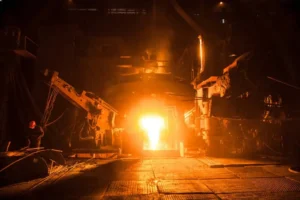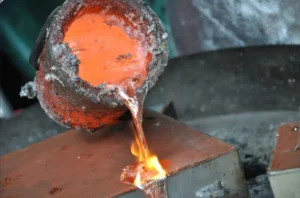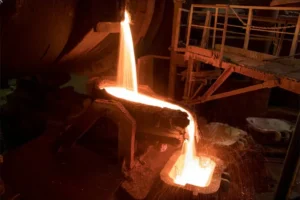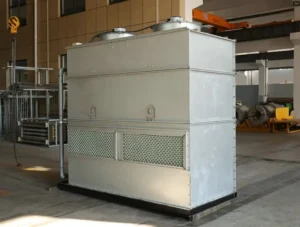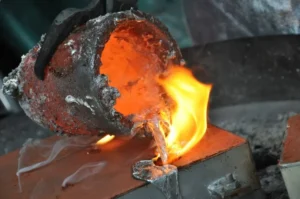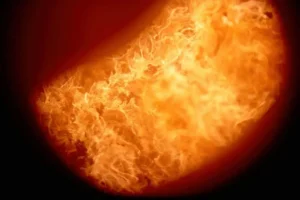เทคโนโลยีการเหนี่ยวนำความถี่หลายความถี่เป็นวิธีการขั้นสูงที่ใช้การรวมกันของความถี่ในกระแสเหนี่ยวนำที่แตกต่างกันเพื่อให้ได้เส้นโค้งความร้อนที่แม่นยำและซับซ้อนมากขึ้น, การประมวลผลวัสดุที่หลากหลายอย่างมีประสิทธิภาพ.
เทคโนโลยีนี้เอาชนะข้อ จำกัด ของการเหนี่ยวนำความร้อนแบบดั้งเดิมแบบดั้งเดิม, แสดงศักยภาพที่ดีในการประมวลผลวัสดุและการรักษาความร้อน.
ความร้อนแบบหลายความถี่ทำงานอย่างไร
สาระสำคัญของการให้ความร้อนแบบเหนี่ยวนำคือการสร้างกระแสวนภายในวัสดุนำไฟฟ้าโดยใช้การเหนี่ยวนำแม่เหล็กไฟฟ้า. กระแสน้ำวนเหล่านี้, ในทางกลับกัน, ผลิตความร้อนจูลเนื่องจากความต้านทานของวัสดุ. ความลึกของความร้อน (หรือ “ความลึกของผิวหนัง”) มีความสัมพันธ์อย่างใกล้ชิดกับความถี่ปัจจุบัน:
- ความถี่สูง: ส่งผลให้ผิวตื้นลึก, มุ่งเน้นความร้อนบนพื้นผิวของวัสดุ. เหมาะสำหรับการชุบแข็งพื้นผิว, การประสาน, ให้ความร้อนแก่ชิ้นงานขนาดเล็ก, และการใช้งานที่ต้องการความร้อนพื้นผิวอย่างรวดเร็ว.
- ความถี่ต่ำ: สู่ผิวที่ล้ำลึกยิ่งขึ้น, ปล่อยให้ความร้อนทะลุเข้าไปในวัสดุได้มากขึ้น. เหมาะอย่างยิ่งสำหรับการให้ความร้อนผ่าน, การทำความร้อนชิ้นงานขนาดใหญ่, การรักษาความร้อนลึก, และละลาย.
โดยทั่วไประบบทำความร้อนแบบเหนี่ยวนำหลายความถี่จะมีหน่วยพลังงานอิสระหลายหน่วย, แต่ละอันสามารถส่งออกกระแสที่ความถี่ต่างกันได้. โดยการควบคุมความถี่เอาต์พุตอย่างแม่นยำ, พลัง, และระยะเวลาของหน่วยกำลังเหล่านี้, คุณสามารถบรรลุได้:
- เครื่องทำความร้อนแบบชั้น: ตัวอย่างเช่น, คุณสามารถอุ่นชิ้นงานได้อย่างสม่ำเสมอด้วยความถี่ต่ำ, แล้วจึงให้ความร้อนหรือทำให้พื้นผิวแข็งตัวอย่างรวดเร็วด้วยความถี่สูง.
- การทำความร้อนแบบไล่ระดับ: สร้างการกระจายอุณหภูมิที่แตกต่างกันภายในพื้นที่ต่างๆ ของชิ้นงานเดียวกัน, เช่นการไล่ระดับอุณหภูมิตามแท่งยาว.
- การควบคุมอุณหภูมิที่แม่นยำ: สำหรับชิ้นงานที่มีรูปทรงเรขาคณิตที่ซับซ้อนหรือวัสดุที่ไวต่ออุณหภูมิ, คุณสามารถปรับการผสมความถี่แบบไดนามิกตามความต้องการความร้อนเฉพาะของภูมิภาคต่าง ๆ, นำไปสู่การควบคุมอุณหภูมิที่แม่นยำยิ่งขึ้น.
บรรลุเส้นโค้งความร้อนที่ซับซ้อนมากขึ้น
เส้นโค้งความร้อนที่ซับซ้อนหมายถึงการเปลี่ยนแปลงที่ไม่ใช่เชิงเส้นในอุณหภูมิของชิ้นงานเมื่อเวลาผ่านไปหรือตำแหน่งในระหว่างกระบวนการให้ความร้อน. การเหนี่ยวนำความถี่หลายความร้อนให้ความสำเร็จผ่านสิ่งนี้ผ่าน:
- การสลับความถี่: ระบบสามารถสลับหรือรวมความถี่ปัจจุบันที่แตกต่างกันโดยอัตโนมัติในระหว่างขั้นตอนต่าง ๆ ของกระบวนการให้ความร้อน. ตัวอย่างเช่น, อาจใช้ความถี่ต่ำกว่าสำหรับการให้ความร้อนเริ่มต้นอย่างรวดเร็ว, เปลี่ยนเป็นความถี่ที่สูงขึ้นสำหรับการให้ความร้อนบนพื้นผิวหรือถือเมื่อถึงอุณหภูมิที่แน่นอน.
- การประสานงานและการควบคุมเวลา: โดยการผสมผสานกำลังเอาท์พุตและระยะเวลาของความถี่ต่างๆ, คุณสามารถควบคุมอินพุตความร้อนได้อย่างแม่นยำ, จึงติดตามเส้นโค้งอุณหภูมิ-เวลาที่ต้องการ.
- การออกแบบมัลติคอยล์: สำหรับชิ้นงานที่มีรูปร่างซับซ้อน, คุณสามารถออกแบบขดลวดเหนี่ยวนำอิสระได้หลายตัว, แต่ละอันขับเคลื่อนด้วยกระแสความถี่หรือพลังงานที่แตกต่างกัน. ซึ่งช่วยให้สามารถปรับเส้นโค้งการให้ความร้อนตามภูมิภาคต่างๆ ของชิ้นงานได้.
- ระบบตอบรับแบบวงปิด: การรวมเซ็นเซอร์ เช่น เทอร์โมมิเตอร์อินฟราเรด ช่วยให้สามารถตรวจสอบอุณหภูมิชิ้นงานได้แบบเรียลไทม์. บมจ (คอนโทรลเลอร์ลอจิกที่ตั้งโปรแกรมได้) หรืออัลกอริธึมขั้นสูงจะสามารถปรับความถี่และกำลังได้แบบไดนามิกเพื่อให้แน่ใจว่าเส้นโค้งการให้ความร้อนตรงกับเป้าหมายที่ตั้งไว้.
การประมวลผลวัสดุที่แตกต่างกัน
วัสดุต่างชนิดกันมีค่าการนำไฟฟ้าต่างกัน, การซึมผ่านของแม่เหล็ก, และคุณสมบัติทางอุณหฟิสิกส์, ทั้งหมดนี้ส่งผลกระทบต่อพฤติกรรมของพวกเขาในระหว่างการทำความร้อนเหนี่ยวนำ. การเหนี่ยวนำความถี่หลายความร้อนนั้นมีความพร้อมในการประมวลผลวัสดุที่หลากหลายเนื่องจากความสามารถในการ:
- ปรับให้เข้ากับคุณสมบัติแม่เหล็กไฟฟ้าของวัสดุ:
- การนำไฟฟ้า: วัสดุที่มีค่าการนำไฟฟ้าสูง (เหมือนทองแดง, อลูมิเนียม) ต้องการความถี่ที่สูงขึ้นเพื่อให้ความร้อนแก่พื้นผิวอย่างมีประสิทธิภาพ. สำหรับวัสดุที่มีค่าการนำไฟฟ้าต่ำกว่า, ความถี่ที่ต่ำกว่าสามารถเจาะลึกลงไปได้. ระบบหลายความถี่สามารถเลือกช่วงความถี่ที่เหมาะสมที่สุดตามค่าการนำไฟฟ้าของวัสดุ.
- การซึมผ่านของแม่เหล็ก: วัสดุ Ferromagnetic (เช่นเดียวกับเหล็กด้านล่างจุดคูรี) มีการซึมผ่านแม่เหล็กสูง, ซึ่งสร้างการสูญเสีย hysteresis เพิ่มเติมในระหว่างการทำความร้อนเหนี่ยวนำ, นำไปสู่ประสิทธิภาพที่สูงขึ้น. เมื่ออุณหภูมิเกินจุดคูรี, วัสดุสูญเสียแม่เหล็กของมัน, มีผลต่อประสิทธิภาพการให้ความร้อน. ระบบความถี่หลายความถี่สามารถปรับความถี่และพลังงานเพื่อรองรับการเปลี่ยนแปลงในคุณสมบัติแม่เหล็กของวัสดุที่อุณหภูมิต่างกัน.
- เพิ่มประสิทธิภาพการให้ความร้อน: สำหรับวัสดุเฉพาะ, มีความถี่ความร้อนที่ดีที่สุดที่ช่วยเพิ่มประสิทธิภาพการแปลงพลังงาน. ระบบความถี่หลายความถี่ช่วยให้ผู้ประกอบการสามารถเลือกหรือรวมความถี่ที่ดีที่สุดตามลักษณะของวัสดุ, เพิ่มประสิทธิภาพการให้ความร้อนและลดการใช้พลังงาน.
- วัสดุคอมโพสิตกระบวนการ: สำหรับวัสดุคอมโพสิตที่ทำจากส่วนประกอบนำไฟฟ้าและไม่นำไฟฟ้าต่างๆ, ความร้อนแบบหลายความถี่สามารถออกแบบเพื่อเลือกความร้อนเฉพาะชิ้นส่วนนำไฟฟ้า, หรือเพื่อให้ได้ความร้อนโดยรวมที่สม่ำเสมอโดยการปรับความถี่และพลังงาน.
สถานการณ์แอปพลิเคชัน
เทคโนโลยีการทำความร้อนแบบเหนี่ยวนำหลายความถี่มีบทบาทสำคัญในการใช้งานที่ซับซ้อนและมีความต้องการสูง:
- การอบชุบด้วยความร้อนของชิ้นส่วนที่ซับซ้อน: ตัวอย่างเช่น, เพลาข้อเหวี่ยงหรือเกียร์ของยานยนต์ที่ต้องการความลึกในการชุบแข็งหรือการแบ่งเบาบรรเทาในส่วนต่างๆ ที่แตกต่างกันเพื่อให้ได้คุณสมบัติทางกลที่เหมาะสมที่สุด.
- บูรณาการความร้อนผ่านและการปรับเปลี่ยนพื้นผิว: ในบางกระบวนการ, ชิ้นงานอาจต้องได้รับความร้อนผ่าน, ตามด้วยการชุบแข็งพื้นผิวความถี่สูงอย่างรวดเร็วเพื่อสร้างชั้นที่ทนทานต่อการสึกหรอ.
- การเชื่อมวัสดุที่ไม่เหมือนกัน: เมื่อบัดกรีหรือเชื่อมโลหะต่าง ๆ โดยมีค่าการนำไฟฟ้าและจุดหลอมเหลวที่แตกต่างกัน, เครื่องทำความร้อนแบบเหนี่ยวนำหลายความถี่นำเสนอโซลูชันการทำความร้อนที่ยืดหยุ่นมากขึ้น.
- การทำความร้อนวัสดุที่ไม่ใช่แม่เหล็กไฟฟ้า: ในขณะที่การให้ความร้อนแบบเหนี่ยวนำของวัสดุที่ไม่ใช่เฟอร์โรแมกเนติก เช่น ทองแดงและอะลูมิเนียม อาจเป็นเรื่องที่ท้าทาย, ระบบหลายความถี่สามารถให้ความร้อนแก่วัสดุเหล่านี้ได้อย่างมีประสิทธิภาพผ่านการผสมผสานระหว่างกำลังสูงและความถี่เฉพาะ.
- การควบคุมอุณหภูมิที่แม่นยำสำหรับ R&ดี: ในการวิจัยด้านวัสดุศาสตร์, ตัวอย่างมักต้องการการหมุนเวียนของอุณหภูมิที่แม่นยำหรือการทำความร้อนแบบไล่ระดับ. การทำความร้อนแบบเหนี่ยวนำหลายความถี่ช่วยให้ได้โปรไฟล์การทำความร้อนที่ซับซ้อนเหล่านี้.
สรุป, เทคโนโลยีการทำความร้อนแบบเหนี่ยวนำหลายความถี่ให้ความยืดหยุ่นและการควบคุมที่ละเอียดยิ่งขึ้น, ช่วยให้เครื่องทำความร้อนแบบเหนี่ยวนำสามารถปรับให้เข้ากับการใช้งานทางอุตสาหกรรมและประเภทวัสดุได้หลากหลาย. สิ่งนี้นำมาซึ่งข้อได้เปรียบที่สำคัญสำหรับการผลิตและการแปรรูปวัสดุที่ทันสมัย.


